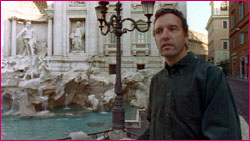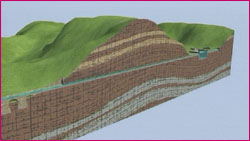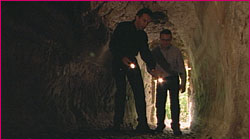
|
 |
Peter Aicher is an Associate Professor of Classics at the University of Southern Maine and one of the Roman experts who assisted NOVA in the making of the documentary, "Secrets of Lost Empires: Roman Bath." We asked Aicher, author of "Guide to the Aqueducts of Ancient Rome," about the Romans' sophisticated water distribution system, including its elegant aqueducts. Here's what he told us: NOVA: I thought we'd begin by looking at the big picture. What would Rome and the Roman Empire have been like without their aqueducts? What did these water bridges mean to their civilization? AICHER: The Romans could not have built cities as big as they did without aqueducts—and some of their cities wouldn't have existed at all. Romans sometimes built cities on dry plains. They'd find a spring in the mountains and take that water into the city, which would not have been possible without the transported water. With the water, they could have their baths, their fountains, and their drinking water. It also would be impossible to imagine Rome, which had about 1,000,000 people at its peak, without its large aqueducts. The Romans could have obtained their water from the river, wells, and springs, but these sources would have become polluted in a large city. Their society would have been very different without imported water. There would not have been a bath culture. Also, the city wouldn't have been nearly as clean—visitors to Rome at the time were amazed at the cleanliness. The hidden half of the water system—sewers—took aqueduct overflow and flushed the refuse into the river, which damaged the river, but kept the city of Rome clean.
AICHER: It was a quasi-science. There were rules of thumb and long traditions of places to look for water. Vitruvius wrote ten books on architecture and he wrote about finding water. Some of his advice is obvious, like looking for mist or a lake and checking the water quality. He recommends talking to the local inhabitants around a water source to see what their complexions are like. If they looked healthy, that might mean that their water source was pure and worth tapping. The Romans carefully checked the source of water. Did it look attractive? Was it brackish? Streams and lakes could be a problem. Frontinus, who wrote a handbook on the Roman aqueduct system in about A.D. 100, describes how the water would arrive in town muddy after a storm in the countryside. You'd suddenly see this muddy water coming out of the fountains. To some degree, they could clean that water up. Or they could divert it to industrial uses or irrigation, where cleanliness was not as important. The really prized waters in Rome came from springs. They were harder to find because the springs often lay underground. There are certain techniques the Romans used for figuring out where to dig a well to find the spring. For instance, green grass in a dry season or a certain manner of vegetation could be indicators. It was difficult; springs do not always bubble up to the surface. Sometimes they would dig down to the water table and build an underground tunnel to begin the aqueduct.
AICHER: Yes. A tunnel might be five, 10, or even 20 feet down. They couldn't pump the water up, because it wasn't practical. So they would dig a tunnel right from the beginning. Some of these aqueducts are almost entirely underground. NOVA: Were there advantages or disadvantages to building tunnels? AICHER: There were definitely advantages. Tunnels don't disturb surface activities such as farming or traffic, and that's a plus. Think of what highways today can do to a neighborhood. Tunnels also were less vulnerable to wind erosion, the weather, and earthquakes. One of the first aqueducts in Rome was built entirely underground for security reasons. Underground, it wasn't vulnerable to enemies. When you build arches, it's like advertising to the enemy: Here is our aqueduct. As Rome grew and the borders spread 1,000 miles away, that was no longer a concern. They weren't worried about the enemy getting to them. When Rome was besieged by the Barbarian invasions, one of the first things they did was to cut the aqueducts into the city. So you see how it hangs together. The security of Rome and the building of a stable empire allowed the stupendous archways, these arcades, to be safely built. Continue: Arcades A Day at the Baths | Construct an Aqueduct | Watering Ancient Rome NOVA Builds a Bath | Real Roman Recipes | Resources | Transcript Medieval Siege | Pharaoh's Obelisk | Easter Island | Roman Bath | China Bridge | Site Map Editor's Picks | Previous Sites | Join Us/E-mail | TV/Web Schedule About NOVA | Teachers | Site Map | Shop | Jobs | Search | To print PBS Online | NOVA Online | WGBH © | Updated November 2000 |
 Peter Aicher, aqueduct expert, stands in front of
Rome's Trevi fountain, which still relies on sections
of an ancient aqueduct for its water.
Peter Aicher, aqueduct expert, stands in front of
Rome's Trevi fountain, which still relies on sections
of an ancient aqueduct for its water.
 Romans used tunnels to get to prized underground
springs and bring water through hills and mountains.
Romans used tunnels to get to prized underground
springs and bring water through hills and mountains.
 Aicher and Roman bath scholar Garrett Fagan explore
aqueduct tunnels, a major feature of Roman aqueducts.
Aicher and Roman bath scholar Garrett Fagan explore
aqueduct tunnels, a major feature of Roman aqueducts.